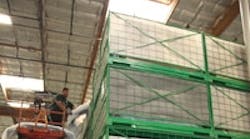The company that finds a way to eliminate most recurring costs gains a significant fiscal advantage over its competitors. This is a stunningly simple concept, and it’s the basis for the successful application of reusable metal shipping crates.
Reusables make logistics processes green and profitable by reducing the amount of packing materials needed, recycling shipping containers, and enabling owners to reuse crates in cost-effective and convenient ways.
Reduce
Reusable crates reduce costs and refuse. They eliminate disposable packaging and shipping materials, such as shrink wrap, bubble wrap and other packing matter, as well as pallets.
And by cutting pallet usage, companies no longer have to purchase and arrange for outside storage of fumigated or heat-treated wooden pallets. This reduces materials and storage costs.
There are many options for returnable containers. Those that offer the best cost-savings reduce the number of shipping containers used to transport goods because they are designed around the inside dimensions of a 53-foot trailer.
Various crate sizes allow for flexibility in transport and for customers to mix small, medium and large-sized crates to fully maximize trailer volume.
Even companies with uniquely shaped or especially fragile products benefit from using reusable crates by contracting with providers for customized versions.
This is how Energy Innovations of Poway, Calif., gained an advantage in the solar panel market. In 2009, Energy Innovations purchased custom designed reusable crates to protect its solar panels while in transit, thereby cutting shipping costs by reducing the need for additional custom crate production for new shipments.
Reuse-for Storage
Reuse not only means using an item more than once, but using it for a different function. Some metal crates have an additional advantage over the use of traditional shipping methods in that they are traceable and collapsible, where they can be reduced down to as little as seven inches high, making them easy to store and ship.
An added benefit allows some metal crates to be stackable and reused as flexible racking, because they interlock for safe stacking and allow for access to products via folding and removable panel doors. This means they can be used as storage racks, then folded and stored or shipped back, meeting seasonal peak and valley storage requirements.
One of the best examples of employing reusable metal crates for flexible storage solutions comes from the automotive industry. There is a seasonality to car bumpers, where more are needed in the winter months due to higher numbers of accidents. Companies that provide bumpers to repair shops can receive them in reusable shipping crates then have the crates stacked and remove panel doors for immediate access to the products for sales to customers. As warmer months approach, the crates can be folded down and sent back to the logistics company, and the floor space can be used for other merchandise.
The retail industry also stands to benefit from this practice. For example, every October, scores of Halloween shops pop up in cities across the United States to sell decorations, costumes and party supplies to pranksters and partygoers. Often, purveyors rent or buy then store racking.
Retailers can deliver products in their crates, taken directly from shipping containers, to store sites for subsequent configuration into temporary racking by stacking them in storerooms. The products are then ready for immediate access. When the holiday is over, the same crates can be folded and shipped back to the logistics company, or they can be stored using less space than that required by traditional racking systems.
Recycle
By returning metal crates to a warehouse for reuse, companies recycle them and therefore eliminate the cost of buying or using additional crates, boxes or other containers. This means sustainable cost savings for many years.
Recycling crates takes a concept created by Malcolm McLean, credited with revolutionizing the containerized movement of goods, one step further in the supply chain. As with cargo containers, recycling the crates opens the door for standardization, which increases efficiency as loading and unloading of goods is automated.
Crate sizes are predictable, allowing for equipment to move them quickly and store them with minimal adjustment. Also, with the reusable crates being returned into the transportation cycle, they are on hand and readily available for new shipments. This equates to reduced time needed for custom built crates and keeps unwanted, unusable crates out of landfills.
Automotive giant, American Honda, realized significant operational savings of over $30 million by recycling and reusing its shipping containers on a global scale.
By reducing the packing materials needed to safely get products to their destinations, recycling via reusable metal crates, and finding ways to reuse the crates by taking advantage of their removable panel doors and interlocking stacking mechanisms for storage, companies are practicing cost-saving, sustainable logistics.
Gregg Healy, Jr., is vice president of Komyo Logistics, a 3PL provider offering patented reusable crates.




